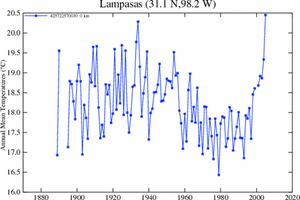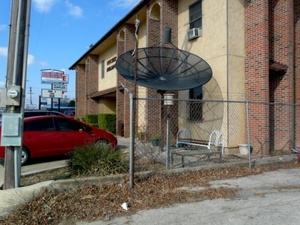Climate Rorschach Test
Over at Climate Skeptic, I have what could be called a climate Rorschach test. Look at these two images below. The left is the temperature plot for Lampasas, Texas, a station in the NASA GISS global warming data base. On the right is the location of the temperature station since the year 2000 (the instrument is in the while cylinder in the middle of the picture under the dish). Click either picture to expand
So here is the eye test: Do you read the warming since 2000 as man-made global warming due to CO2, or do you read it as a move of the temperature instrument to a totally inappropriate urban site to which the instrument was moved in 2000, contaminated with hot asphalt, car radiators, nearby buildings, air conditioning exhaust, etc?
You should know that NASA's GISS reads this as man-made global warming, and reports it as such. Further, NASA actually takes the raw data above and in their computer model lowers temperatures in 1900 and 1920, actually increasing the apparent warming trend. For the record, the GISS opposes this kind of photo survey as worthless and argues that their computer algorithms, which correct for urban warming at this site in 1900 but not in 2007, work just fine with no knowledge of the specific site location.


Ironman:
Well, you have to admit, the global warming here is entirely man-made....
February 18, 2008, 1:09 pmMoosashi:
If the rise in temperature was caused only by the movement of the instrument from one location to another, you would see oscillation around a mean before the year 2000, then a jump in a single year to a new mean. That is not the case here. The temperature continues to rise after the move. Some of the change can be attributed to the shift in location, but not all. Either the overall climate in this region is getting warmer (assuming the trend since 2000 is significant) or the immediate urban environs are getting warmer. If the latter is true, you should be able to point to an increasing preponderance of "hot asphalt, car radiators, nearby buildings, air conditioning exhaust, etc."
That said, this is shoddy science. The GISS climatologists should make every effort to place the instrument in a location that is representative of the natural physical conditions of the region the instrument is intended to sample. I wouldn't think such a course would be difficult or irrelevant. Factoring out urban heat using an algorithm would never be better than an approximation, so it necessarily increases the error in the final result. Why introduce that error if you don't have to? (answer: the error pushes your data in the desired direction: global warming).
February 18, 2008, 1:42 pmMark:
"The temperature continues to rise after the move"
But those could ALSO mean the normal variations in temperature, not the rise in temperature.
February 18, 2008, 1:46 pmClint:
It would be nice to have photos over time to "be able to point to an increasing preponderance of 'hot asphalt, car radiators, nearby buildings, air conditioning exhaust, etc.'"
Did the scientist maintaining and monitoring this thermometer take such pictures or records?
February 18, 2008, 3:25 pmJimK:
"For the record, the GISS opposes this kind of photo survey as worthless and argues that their computer algorithms, which correct for urban warming at this site in 1900 but not in 2007, work just fine with no knowledge of the specific site location."
This is eerily similar to he arguments made by those who securitized subprime mortgages. They believed the broad statistical assumptions about the behavior of a pool of mortgages using complex computer models would offset the simple commonsense observation that each underlying mortgage was a piece of junk. We have seen how well that worked out. Classic example of GIGO
February 18, 2008, 6:59 pmFrederick Davies:
It would be interesting to know if the sensor was moved around 1960 too; the temperatures seem to suddenly drop; though the break is certainly "smoother" than in 2000.
How frequent are these sensor movements? Maybe checking on a move that happened 20-30 years ago to see if there is a break in the data before and after could determine if the algorithms are worth anything.
February 19, 2008, 1:25 amdearieme:
Climate Science doesn't much resemble real science, does it? Now we need three categories: Science, Social Science, Climate Science.
February 19, 2008, 5:15 amdiz:
While the case studies provided in the "How not to measure temperature" series are amazing examples that seem to border on sceintfic fraud, the bigger question remains "How much does this matter?"
Even most leading "skeptics" seem to acknowledge there has been some warming over the last century.
Is that just a case of groupthink caused by reliance on the same flawed data? Or is there enough other evidence to support that warming has occurred?
February 19, 2008, 8:04 amSteve G:
I agree with the sentiments about the placing of this station being dubious - just by an 'eye' inspection alone. In addition, looking at the graph I find it intruiging that the short-term oscillations before the 2000 move seem to have been completely ironed out. That to me is a warning that something is decidedly not right about its new position.
February 19, 2008, 11:26 amSteve G:
I agree with the sentiments about the placing of this station being dubious - just by an 'eye' inspection alone. In addition, looking at the graph I find it intruiging that the short-term oscillations before the 2000 move seem to have been completely ironed out. That to me is a warning that something is decidedly not right about its new position.
February 19, 2008, 11:28 amEric McFarland:
Site looks rural if you actually map it:
February 19, 2008, 5:11 pmhttp://maps.google.com/maps?f=q&hl=en&geocode=&q=31.1n,+98.2w&ie=UTF8&ll=31.101599,-98.200006&spn=0.007607,0.012167&t=h&z=16
Adirian:
Eric, my guess would be that those aren't precise coordinates. If you zoom out, approximations from virtually any directions can land you in a city. Check out the coordinates at http://maps.google.com/maps?f=q&hl=en&geocode=&q=31.06n,+98.2w.
February 19, 2008, 6:15 pmskh.pcola:
Doesn't matter what the site "looks like" from an orbital photo. I could go out into a million-acre forest, clear an acre, asphalt the acre with the blackest material available, set up a thermometer station, and record wildly elevated temps. What matters is what the site looks like when you are actually looking at the damned thing...like, in the picture above. A frackin' barbeque grill in the middle of Siberia will still be as hot as one in Tucson.
February 19, 2008, 11:20 pm